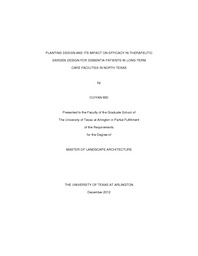| dc.description.abstract | This research addresses planting design and its therapeutic benefits for bringing lifeenhancing therapy to people dealing with dementia. The senses heightened by plants have proven to be powerful stimulators of early, emotional childhood memories due to the structure and evolution of the human brain (Minter, 2005). Plant materials used in therapeutic gardens are carefully chosen to stimulate the senses of dementia patients (Cooper Marcus and Barnes, 1999; Minter, 2005; Chalfont, 2008) and to enhance safety and security, orientation, stimulation, and autonomy. Many long-term care facilities for dementia patients have been built in the United States to provide settings for optimal care (Desai and Grossberg, 2010). A number of studies demonstrate the healing benefits of plants and the natural environment as well as the benefits of outdoor spaces for dementia patients (Carstens, 1998). However, researchers suggest that there is a need for more empirical studies on the therapeutic or healing benefits of gardens in healthcare facilities (Cooper Marcus and Barnes, 1995, cited in Ghose, 1999). This study adapts the theoretical, anecdotal and clinical research of the therapeutic effects of plants and nature into the realm of landscape architecture. A set of preliminary planting design recommendations used for therapeutic gardens is proposed from the review of relevant theories and research. The study primarily follows qualitative research methods (Taylor and Bogdan, 1998) and evaluation (Rossi et al., 2004), to assess the patterns of use in existing gardens and the possible therapeutic benefits experienced by their users. Interviews are conducted with staff and residents' family members in long-term care settings. Passive observations of the residents are utilized as supporting data. The preliminary planting design guidelines are tested against the existing qualities of the therapeutic gardens relative to the preference of the users. Landscape architects designing gardens for dementia residents in long-term care facilities can include plants which are non-toxic, harmless, colorful, and aromatic, have seasonal interest and fine texture, produce therapeutic sound, attract wildlife, and provide appropriate sun or shade. Also, horticulture therapy as a practice needs to be used for residents' physical, psychological and social benefits. Chosen either to suit a particular group of residents, or as an expression of a regional plant and materials palette, these gardens can be used by horticultural therapists and nursing staff to provide many beneficial outcomes to dementia residents. | en_US |

